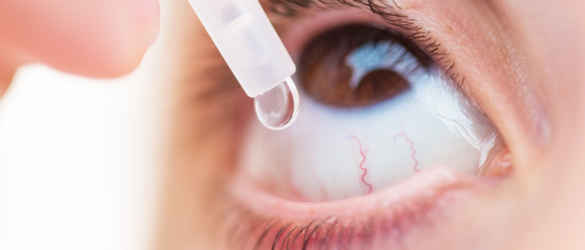
Treatments
Dry age-related macular degeneration
Dry age-related macular degeneration (AMD) is a slow deterioration of the cells of the macula, often over many years. Currently, there are no approved medical treatments for dry AMD, but research is going on around the world, including projects funded by the Macular Society. See more information below on what is in the works.
Wet age-related macular degeneration
Wet AMD is another form of the condition. It is caused by tiny abnormal blood vessels growing into the retina which leak and cause scarring of the macula. A person with wet AMD can lose much of their central vision in a few weeks. There are several treatments for wet AMD which slow the progress of the condition in most people. Treatment has to be given quickly, before there is permanent scarring to the macula.
The National Institute for Health and Care Excellence (NICE)
Clinical Guideline recommends that people with suspected wet AMD should be referred to a retinal specialist immediately. If treatment is needed, it should be given within 14 days of the initial referral. Optometrists who suspect someone has wet AMD should refer the person directly to a retinal specialist at a hospital and not refer via GP.
Video: What you need to know about treating AMD and other macular conditions
Dry AMD
Researchers are looking at different ways to find treatments for AMD.
AMD is a complex disease that is still not fully understood. A popular approach for late-stage dry AMD treatments, also known as geographic atrophy (GA), is to look for drugs which will reduce inflammation in the macula, as inflammation causes damage and leads to sight loss. Another approach is to try and keep the photoreceptors alive for longer. Both approaches would slow the progress of the disease.
The first two drugs have been approved for use in the USA. These drugs are called Syfovre and Izervay, and both look to reduce inflammation in the eye, which is believed to be involved in GA progression.
Pegcetacoplan, produced by drugs company Apellis, will be marketed under the name Syfovre. It’s administered through eye injections either monthly or every other month. In the UK, the Medicines and Healthcare products Regulatory Agency (MHRA) declined to approve Syfovre.
While the MHRA recognised the effect of Syfovre on slowing the rate of progression of GA, they were concerned about whether it meaningfully improved patients’ ability to see and manage daily tasks during the trial period. Syfovre has also been rejected for approval by European regulators.
The second drug to be approved in the USA is avacincaptad pegol, marketed under the name Izervay and produced by Astellas. It has a similar action to Syfovre and is also an eye injection given monthly or every other month. This drug is currently being considered by the MHRA for approval in the UK.
It's important to note that the aim of both drugs is to slow the speed of deterioration. Neither drug claims to restore vision. In clinical trials for Syfovre and Izervay, results showed that treatment slowed the spread of damage in the macula. However, those receiving treatment were found to have a higher risk of developing wet AMD.
There are many other treatments for dry AMD and GA currently being investigated in clinical trials. Some trials are looking at new delivery methods, including oral tablets.
Wet AMD
Several drugs are used to treat wet AMD. They are known as ‘anti-VEGF’ drugs. VEGF is short for Vascular Endothelial Growth Factor. It is the substance in the body that is responsible for the development of healthy blood vessels.
In wet AMD, too much VEGF is produced in the eye, causing the growth of unwanted, unhealthy blood vessels. Anti-VEGF drugs block the production of VEGF and stop the development of abnormal blood vessels.
All anti-VEGF drugs need to be delivered directly into the eye.
The current method is injections, however new methods are being delivered. Don’t worry, they are much less frightening than they sound.
In accordance with NICE AMD guidelines, all patients receive a standard ‘loading dosage’ at the start of their injection treatment: normally three or more consecutive monthly injections.
After this initial phase there are a number of treatment regimens that an ophthalmologist can choose. Each regimen has a subtle difference in the frequency of appointments. They also vary as to whether or not you have an injection at every appointment. The ophthalmologist will tailor treatment to individual patients and how their disease is responding to treatment.
Top tip
We recommend that patients ask their eye doctor, after their initial loading doses, what treatment regimen they are on, and what to expect at each appointment.
From this, patients will be better able to understand the timescale between injections and feel confident that they are not being overlooked in the clinic appointment system or missing any treatment.
Current anti-VEGF treatments
There are a few different medications used to treat wet AMD. They all are effective in treating the eye. The main difference between them is how long they last in the eye. Not everyone responds well to every medication, hospitals will treat a patient with the most suitable medication for the patient’s needs.
Avastin (bevacizumab) may be used in some circumstances. But Avastin® is an anti-VEGF drug that was developed to treat cancer and is not licensed for use in the eye. It is still safe and effective to treat wet AMD.
Lucentis (ranibizumab) was the first anti-VEGF to be licensed for wet AMD. Patients may need to go for treatment every four weeks with this medication.
Eylea (aflibercept) is longer lasting in the eye compared to Lucentis, on average a patient may only need to attend treatment every eight weeks. Eylea is typically given at a 2mg dose, but a higher dose of Eylea 8mg has been approved for use in the UK. This has a higher concentration of the drug, and patients may only need treatment every eight to 16 weeks.
Beovu (brolucizumab) is longer-acting than the previous treatments, and needs to be injected only around every 12 weeks. Patients who react well to the drug could have their injections spaced even further apart.
Vabysmo (Faricimab) is the most recently approved medication for treatment of wet AMD. It is the first dual action drug and tackles two biological pathways involved in blood vessel growth, VEFG and Ang-2. It is also longer acting and patients may be able to go 12 or 16 weeks between injections.
Vabysmo is being rolled out through NHS eye units across the UK. Please contact your ophthalmologist to learn more about your area and how this may affect you.
Biosimilar treatments
New forms of anti-VEGF drugs are now available to treat wet AMD, called biosimilars. The first to become available is Ongavia, a biosimilar to ranibizumab.
A biosimilar is a medicine developed to be highly similar to an existing biological medicine. Biosimilars might vary slightly from the original brand of medicine, but they work in the same way and they are equally safe and effective.
Biosimilars are already being used in the NHS for several conditions, used to treat a range of inflammatory conditions in the joints, skin, gut and eyes. A biosimilar goes through extensive tests in the laboratory and in clinical trials to compare it with the original medicine. It must be proven to match the original medicine, and to work as well as the original in a disease that the original medicine is approved to treat. Once testing is complete, the manufacturing company submits the results for approval.
In the UK this is done by the MHRA.
How is the injection given?
The majority of patients are treated at a hospital in a designated injection room. The eye may be examined first to check that an injection is needed. If it is, the procedure may take place on the same day or you may have to return at a later, appropriate date.
When the injection is given, the patient reclines on a chair. An antiseptic solution will be used to clean the surface of the eye. The eye will be held open with a device called a speculum and anaesthetic drops are used to numb it. The patient looks to one side and the injection is given in the opposite corner of the eye. Most patients does not see the needle and the injection only takes a few seconds.
Following the injection, the eye will be cleaned with a normal saline solution. While the majority of patients find this a painless procedure some people say the injections are uncomfortable and occasionally painful.
Others experience discomfort for a while afterwards. Very occasionally there are more severe reactions, mostly due to allergic reaction.
Although a true allergic reaction to iodine (Betadine) is rare, some people find that it causes irritation to their eye or skin. If you experience discomfort or pain after injections, tell your specialist or nurse (most injections administered by nurses). They may use a different local anaesthetic, saline or lubricant drops.
If none of these changes help, they may talk to you about using a different antiseptic called chlorhexidine, which doesn’t contain iodine. Chlorhexidine kills a smaller range of microbes than Betadine. Research has shown an increased risk of eye infection, so your specialist should make sure you fully understand the possible risks. A drop of Betadine will still be used in the exact point the injection will be given. Saline will be used to wash the eye after the injection.
The eye can develop significant discomfort or severe pain about one hour or more after the injection. This may be due to one of a few possibilities, including a scratch on the cornea - the clear glassy part of the eye (called corneal abrasion) which may result in the skin in front of the cornea coming off due to the effect of the anaesthetic as well as dryness of the cornea.
The injection can cause the eye to become very ‘dry’ with a lack of lubrication. This can result in the eyelid sticking to the epithelium layer and when you open your eyes it may cause the layer to be damaged.
Dry eye gel can be used to prevent this from happening after future injections, but please check with your eye care professional before using any product.
Excessive rubbing of the eye soon after an injection may predispose to an abrasion as the patient is unaware as to how much rubbing is taking place (as the eye is still numb).
Patients are advised to call the clinic or return to Eye Casualty immediately if they have any severe eye pain after an injection because treatment is required to reduce the pain and allow the scratch to heal properly, which may take up to 48 hours. The clinic also needs to know that this incident has occurred to avoid a recurrence,
Pain which develops in the eye 24 hours or more after the injection (up to about one week) requires immediate action. Pain, accompanied by redness and vision reduction, indicates an infection inside the eye (called endophthalmitis) which requires urgent treatment – contact your eye casualty department and macular clinic immediately.
The following activities should be avoided for up to 5 days to reduce the risk of an infection:
- Showering
- Washing your hair
- Swimming – even with goggles
- The use of makeup
If you’ve been told you need injections and are worried, you can speak with people who’ve had injections for support and advice. Call our Helpline on 0300 3030 111 for more information.
Injections do not work if there is already longstanding damage to the macula. Around one in 10 people with wet AMD do not respond to treatment.
When will injections stop?
There are two main reasons why patients who previously responded well to treatment may stop injections.
The first is if someone’s macular has too much damage caused by the condition. This means a person has lost the majority of their central vision in that eye and therefore injections are no longer effective and it is in the patient’s best interest that treatment is stopped.
This can be upsetting news, we can support you with our free telephone counselling service, to find out more please contact our Helpline on 0300 3030 111 for more information.
The second is if the blood vessels that are causing the damage have been successfully suppressed and they are no longer leaking onto the macula.
Sometimes a hospital may refer to this as "going dry", "stable" or "inactive" This does not mean you have gone from wet AMD to dry AMD, but that the fluid has now "dried up". In this case, injections can be paused.
Hospitals may ask a patient to return every few months to monitor, or attend a local opticians to monitor their condition. The fluid can start leaking again which means injections may need to be started up again.
If your vision gets worse during this time, it is important to get in contact with an eye care professional so they can assess your condition and restart treatment if necessary. The amount of time injections are paused for is different for every person who is able to pause their treatment.
Top tip
We recommend that anytime your vision appears worse and you are currently receiving treatment, get in contact with your hospital. Your treatment regime may need to be adjusted to help your condition as much as possible.
Laser treatments
On rare occasions some people may be offered laser treatment. A light-sensitive drug is injected into the arm. The drug travels to the eye where it is activated by a laser beam, shutting down the abnormal blood vessels.
Most people need two to five treatments.
The treatment is only suitable for people with particular patterns of damage to the retina. However, as this treatment carries a greater level of risk to the patient it is not routinely offered.
Future treatments
Researchers all over the world are working hard to find new and improved treatments for AMD. This includes researchers funded by the Macular Society. A lot of progress is being made but it may take some years before these treatments become available.
Wet AMD
One area that is being highly researched is the development of longer acting drugs for wet AMD. Longer acting treatments would allow patients to have fewer injections and trips to the eye clinic, and we are starting to see these new drugs become available.
Another way of reducing injections is an implant containing a drug reservoir. The implant is filled with an anti-VEGF drug and inserted into the eye. It then slowly releases the drug over the course of a few months, and will only need refilling every six to nine months.
Research is also underway with the aim of moving away from the need for eye injections completely, but it is still in very early stages.
One way is to replace injections with eye drops. However, this is complicated as our eye is designed to stop things getting into it, including drugs. Also, as the macula is right at the back of the eye, it is difficult to make sure that enough drug is able to make its way to the macula to be effective.
Replacing injections with oral tablets that patients can take once a day is another option. However, we need to make sure that these treatments are safe and won’t have any effects on other parts of the body. Current eye injections mean the drug stays concentrated in the eye, so effects on the rest of the body are limited.
Gene therapy is another approach being researched to reduce the need for injections.
Dry AMD
Among the options being explored are treatments to reduce the inflammation thought to lead to dry AMD. By reducing inflammation in the cells of the retina it’s hoped we can reduce the progression of damage and sight loss. The methods being investigated include injections, tablets and gene therapy.
Stem cell treatment
Another promising approach is stem cell therapy. Many researchers around the world, including in the UK and USA, are looking at replacing cells that have become damaged or died due to macular disease. The hope is that the new eye cells will be able to maintain or even restore some vision.
Clinical trials of stem cell therapies are underway for both wet and dry AMD.
Diabetic macular oedema
Diabetic macular oedema (DMO) can be treated if caught early. Drugs are injected into the eye to stop fluid leaking from the blood vessels. Following diagnosis, people will usually have a number of injection treatments in the first few months. Subsequent check-ups will then be required to assess when more injections are needed.
The injections are not as bad as they might sound. The eye is anaesthetised and the needle goes into the corner of the eye so the patient does not see it. These are called intravitreal injections. The treatment cannot restore sight if there is already significant damage to the macula.
There are four drugs in use for treating DMO: Lucentis (ranibizumab), Eylea (aflibercept) Beovu (Brolucizumab) and Vabysmo (faricimab). They act on the blood vessels in the retina to reduce fluid leakage that leads to oedema in the eye.
The frequency and number of injections depends on how a patient responds to the drug. Ask your eye doctor about your treatment programme. Do not miss a treatment session – any sight loss cannot be recovered.
Another drug Avastin® (bevacizumab), may be used. However, its routine use is to treat cancer and it is not licensed in the UK for treatment in the eye. Some people who have had cataract surgery or who have a particular form of DMO may be offered an intravitreal injection of a steroid drug called Ozurdex® (dexamethasone) or Iluvien® (fluocinolone acetonide). They are slow-release drugs implanted in the eye. Iluvien is suitable for people who have had cataract surgery, whereas you may be offered Ozurdex regardless if you have had cataract surgery or not.
Central serous retinopathy
In most cases, the fluid is reabsorbed without any treatment. The majority of people with central serous retinopathy (CSR) will regain most or all of the sight they had before. If the fluid is still there after three to six months, you may need treatment to prevent more lasting damage to the macula.
One treatment option uses a laser to seal off the leak, but it cannot be used too close to the centre of the macula, as it can damage your central vision. If this is the case, you may be offered photodynamic therapy. This is where a drug is injected into your bloodstream and activated in the eye using a low-energy laser, which won’t damage the macula. You should also be helped to make any lifestyle changes that might help, such as reducing stress or stopping any drugs which could make the condition worse.
Macular hole
If you have a macular hole you will undergo vitrectomy surgery to remove the gel from the eye under local anaesthetic. It is successful in repairing macular holes 90 per cent of the time, and nine out of ten people will see their vision improve. A tiny cut is made in the eye and the vitreous gel is replaced with a bubble. To begin with, the bubble will block your sight, but it is naturally absorbed over several weeks.
One common side-effect of this treatment is cataract: within two years of a vitrectomy, most people will need cataract surgery. If you need a vitrectomy, you may be offered cataract surgery at the same time, if you have not already had it.
After surgery, you may be asked to lie face-down for several days (called “posturing”) to help the eye heal properly.
Myopic macular degeneration
For those who are already short-sighted, little can be done to reduce the risk of maculopathy, although ensuring high blood pressure is controlled is warranted, as high blood pressure is believed to be associated with risk of myopic maculopathy.
The treatment options are similar to those for age-related macular disease (AMD) and depend on the precise cause. For the majority of patients there is no treatment available. Any sudden changes in vision or an increase in 'floaters' should also prompt an urgent check-up visit to the optometrist.
Punctate inner choroidopathy
Treatments fall into short-term ‘rescue’ and long-term ‘prevention’. Rescue treatments use corticosteroid tablets or injections to suppress the inflammation, or anti-VEGF injections to stop new blood vessels spreading and leaking. Once inflammation is brought under control, preventative treatment may be used to reduce the risk of a future flare-up.
These preventative treatments include immune system-suppressing tablets, or a corticosteroid implant in your eye. If your punctate inner choroidopathy (PIC) is mild, you may not be prescribed a preventative therapy, and only take ‘rescue’ medication, if and when needed.
Retinal vein occlusion
Anti-VEGF injections (Eylea, Lucentis) or steroid implants (Ozurdex) injected into the eye is used to treat retinal vein occlusion (RVO). The injections have to be repeated over a period of time to work effectively.
Injection treatment aims to stabilise or improve vision. About 45-55% of patients treated with anti-VEGF injections experience a significant improvement in vision. Steroid implants achieve a significant improvement in vision in up to 30% of patients. 20-30% of patients experience no improvement in vision treatment.
Laser treatment may be used to treat branch retinal vein occlusions.
About 20% of patients with RVO develop abnormal blood vessels that can bleed or increase pressure in the eye, leading to further loss of vision. This can normally be prevented by laser treatment to stabilise and preserve the condition of the eye, but not improve vision.
Last review date: 02 2025
Questions about injections
Eye injections might seem frightening, but they're usually painless. Discomfort or pain during or after an intravitreal injection should never be ignored - even if it's not a symptom of infection, there are ways to make the process less painful in the future.
Support for you
We provide free information and support to those with macular disease, along with their family and friends, to help people keep their independence.
Treatment buddies
We can put you in touch with someone who’s had treatment for macular disease, to answer your questions and put your mind at rest.
Explore our research
Beating macular disease through funding medical research and improving the lives of those living with macular disease.
Free confidential advice and support
Call our helpline on 0300 3030 111
Lines are open 9am - 5pm Monday to Friday
About the Macular Society Helpline





